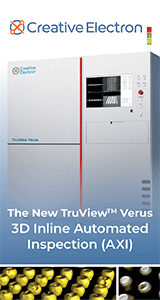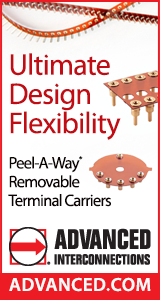|

|
Optimizing Cleaning Strategies for Advanced Packaging Technologies
Materials Tech |
|
Authored By:Ravi Parthasarathy, M.S.Ch.E. ZESTRON Corporation VA, USA Patrick Lawrence ITW EAE MO, USA Evan Griffith Indium Corporation NY, USA SummaryAs computing chips evolve to offer enhanced functionalities, packages like SiP, fcBGA, PoP, and 2.5D have become more intricate, incorporating larger die sizes, increased bump counts, and lower standoff heights. These advancements have posed challenges in achieving effective cleaning. The interconnects in these packages commonly use solder. Post-soldering, flux residues create significant cleaning hurdles, particularly beneath low-profile components. With standoff heights decreasing to less than 50μm, outgassing during reflow diminishes, further complicating flux residue removal. Components such as QFNs and LGAs with large thermal pads add to these challenges, risking reliability issues including electrochemical migration and electrical leakage. Understanding the nuances of cleaning processes, especially in conveyorized spray-in-air inline systems is critical for overcoming these challenges. This study will focus on optimizing cleaning parameters to ensure reliable performance and durability under harsh conditions. From analyzing the arrangement and orientation of spray bars to controlling pressure and spray nozzle distance from the belt of wash and rinse modules, optimizing these parameters is essential to balance cleaning effectiveness while minimizing potential damage to delicate components. The study will utilize various test vehicles with low standoff components, using both No-clean and Water-soluble solder formulations. Two aqueous-based cleaning agents will be evaluated, and cleanliness assessed through visual inspection, SIR, and IC testing following IPC standards. The results will provide insights into optimization advantages, helping manufacturers reduce risk of failures, improve efficiency, and ensure optimal cleaning consistency and repeatability. ConclusionsThe study confirmed that lowering the manifold-to-conveyor spacing height improves cleaning results and broadens the process window. A 2-inch spacing height, in some cases, even allowed for increased conveyor belt speeds compared to 3-inch and 4-inch heights, validating Hypothesis 1. Additionally, it was observed that smaller components were easier to clean than larger ones, likely due to differences in geometry, surface area, and standoff height. Smaller components, such as 008004 and 01005, have significantly reduced surface areas, limiting the accumulation of flux residue and making it easier for the cleaning solution to remove it. The smaller footprint and less migration of flux across the board allow capillary action to more effectively pull residues outward, enhancing cleaning efficiency. In contrast, larger components like 0402 and 0201 present greater challenges due to their larger surface area, which allows more flux to accumulate. These components require stronger cleaning mechanisms as the flux spreads further, and capillary action is less effective at removing residue from underneath. This increases the difficulty in achieving complete residue removal. In summary, smaller components (008004, 01005) are easier to clean due to their smaller surface areas, lower standoff heights, and better accessibility for cleaning solutions. Larger components (0402, 0201), with their greater surface area and flux retention, require more intensive cleaning. Hypothesis 2 was confirmed as valid. Initially Published in the SMTA Proceedings |
|
Comments
|
|
|
|

|


